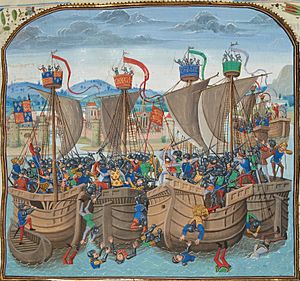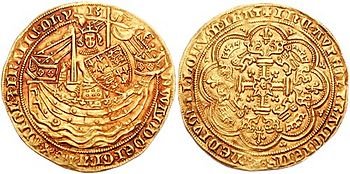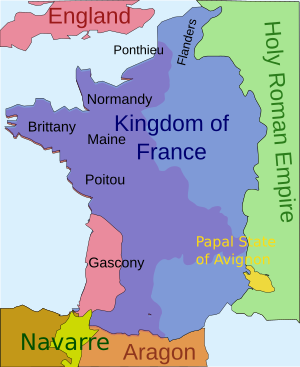Battle of Winchelsea facts for kids
Quick facts for kids Battle of Winchelsea |
|||||||
|---|---|---|---|---|---|---|---|
| Part of the Hundred Years' War | |||||||
 A depiction of medieval naval combat from Jean Froissart's Chronicles, 14th century |
|||||||
|
|||||||
| Belligerents | |||||||
| Commanders and leaders | |||||||
| Strength | |||||||
| 50 ships | 40 ships | ||||||
| Casualties and losses | |||||||
| At least 2 ships lost Heavy human losses |
14–26 ships captured | ||||||
The Battle of Winchelsea, also known as the Battle of Les Espagnols sur Mer (meaning "the Spaniards on the Sea"), was a naval battle fought on August 29, 1350. It was part of the long Hundred Years' War between England and France. In this battle, an English fleet of 50 ships, led by King Edward III, defeated a Castilian fleet of 47 larger ships. The Castilian fleet was commanded by Charles de la Cerda.
The English captured between 14 and 26 Castilian ships, and several more were sunk. The English lost at least two ships, but many lives were lost on both sides. England relied heavily on ships to transport goods and soldiers, especially to its land in Gascony, France. The French hired Castilian ships to block English ports. King Edward III decided to lead his fleet to stop them. Even though the English won, French and allied ships continued to bother English trade and ports.
Contents
Why Did the Battle Happen?
Since the Norman Conquest in 1066, English kings had owned lands in France. This made them vassals, or loyal subjects, of the French kings. By 1337, England only held Gascony in southwestern France and Ponthieu in northern France. After disagreements between King Philip VI of France and King Edward III of England, Philip decided to take back Gascony. This event started the Hundred Years' War, which lasted for 116 years.
Early in the war, French raids attacked English coastal areas. Towns like Portsmouth and Southampton were burned. Many English merchant ships were captured. In 1340, Edward III destroyed the French fleet at the Battle of Sluys. Later, in 1346, the English army marched through northern France, burning and capturing ships. The English then won a big victory at the Battle of Crécy and captured the important French port of Calais. A truce was agreed in 1347, but fighting continued with small attacks.
Trade was very important to England. Over 1,000 ships sailed from Gascony to England each year, carrying huge amounts of wine. Taxes on wine from Bordeaux were the biggest source of income for the English king. Bordeaux, the capital of Gascony, was a large and wealthy city. However, English Gascony had shrunk and needed food imports, mostly from England. If shipping was stopped, Gascony could starve, and England would lose a lot of money. The French knew this well.
How the Battle Started
In November 1349, Charles de la Cerda, a soldier from a noble Castilian family, sailed from Spain. He was hired by the French. He captured several English ships carrying wine and killed their crews. Later, de la Cerda led 47 Castilian ships, loaded with Spanish wool, to Sluys in Flanders. On the way, he captured more English ships and threw their crews overboard.
In early 1350, England and France were trying to renew their truce. But both sides were also planning for more fighting. In February, the French paid 20,000 florins to hire the Castilian fleet as mercenaries. In April, this fleet blocked the English Channel ports. In mid-June, a new truce was agreed, and the Castilians were named in it. Philip VI stopped paying them.
However, the Castilian ships kept attacking the English, acting like pirates. They had turned their trading ships into warships by adding wooden "castles" (raised fighting platforms) at the front and back. They also added crow's nests at the top of the mast for fighters. Hundreds of Flemish adventurers joined them, hoping for treasure. Their attacks on English ships were very fierce and caused panic in English ports.
On August 10, King Edward III announced he would fight the Castilians. The English fleet gathered at Sandwich, Kent. Edward had good spies in Flanders and knew when de la Cerda's fleet would sail. He left Sandwich on August 28 with 50 ships. His ships were smaller than most of the Castilian vessels. Edward and many important English nobles, including two of his sons, sailed with the fleet. They had many soldiers and archers.
The Battle of Winchelsea
By the afternoon of August 29, the English fleet was near Dungeness. King Edward was on his ship, listening to music. Around 4:00 pm, they saw de la Cerda's fleet approaching with the wind behind them. The Castilian ships were spread out, and the English aimed for their main group of about 24 vessels. When the lookouts spotted the enemy, Edward and his men drank to each other's health, and trumpets sounded.
In those days, naval battles involved grappling (hooking onto) and boarding enemy ships. To make sure the Castilians didn't just sail past, the English also sailed with the wind, but with less sail. This allowed the Castilians to catch up. The fighting began about an hour later.
The King's own ship, the Cog Thomas, hit a Castilian ship so hard that its own timbers cracked. On the second try, it successfully grappled the enemy. English archers shot at Castilians trying to drop rocks from their higher decks. The Castilian ships were much taller than the English ones, "like castles to cottages," as one writer said. English soldiers used ladders to board the Castilian ship and clear its deck. Edward had to move his flag to another ship because the Cog Thomas was sinking.
His son, Edward the Black Prince, had a similar experience. His men barely managed to board their enemy ship before their own ship sank. Their attack was helped by Henry of Grosmont, 1st Duke of Lancaster, who attacked from the other side. The Castilian crossbowmen caused many English casualties, firing from their high positions. The heavier Castilian ships also dropped iron bars or other weights on the lighter English ships, causing damage.
The battle continued until evening. One English ship, La Salle du Roi, carrying the king's household, was being dragged away by a larger Castilian ship. A brave Flemish servant named Hannequin boarded the enemy ship and cut the ropes of its main sail. This allowed other English ships to catch the Castilian, and it was captured.
The English captured between 14 and 26 enemy ships, and some others might have sunk. The number of English ships lost is not known, but since the King's ship and the Black Prince's ship sank, and another was almost captured, it seems the English fleet suffered heavily. Few prisoners were taken, and dead or wounded Castilians were thrown overboard. Much of this battle could be seen from the English shore, and people lined the cliffs near Winchelsea to watch. This is how the battle got its name.
What Happened Next?

The remaining Castilian ships escaped to French ports. They joined with French ships and continued to attack English shipping for the rest of the autumn. They then returned to Sluys for the winter. The next spring, the English Channel was still dangerous for English ships unless they had strong escorts. Trade with Gascony was less affected, but ships had to use ports in western England, which were often far from where the goods were needed.
Historians note that while this was an English victory, it came with heavy losses of English sailors and possibly ships. They also suggest it was just one of many tough naval battles of that time, only remembered because important figures like the King were involved. Most agree that the battle did not change the overall war situation much.
Charles de la Cerda survived the battle. Soon after, he became the Constable of France, a very high military position. With safer communication with Gascony, the English launched a large expedition from there in 1356. This led to a huge French defeat at the Battle of Poitiers. King Edward III continued the war and ended it successfully in 1360 with the Treaty of Brétigny.
See also
 In Spanish: Batalla de Winchelsea para niños
In Spanish: Batalla de Winchelsea para niños


